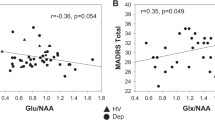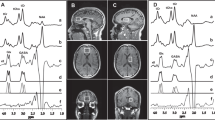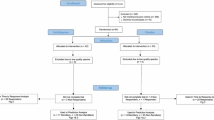Abstract
Glutamatergic abnormalities in corticostriatal brain circuits are thought to underlie obsessive–compulsive disorder (OCD). Whether these abnormalities exist in adults with OCD is not clear. We used proton magnetic resonance spectroscopy (1H MRS) to test our hypothesis that unmedicated adults with OCD have reduced glutamate plus glutamine (Glx) levels in the medial prefrontal cortex (MPFC) compared with healthy controls. Levels of γ-aminobutyric acid (GABA) were also explored. Twenty-four unmedicated adults with OCD and 22 matched healthy control subjects underwent 1H MRS scans at 3.0 T. Resonances of both Glx and GABA were obtained using the standard J-editing technique and assessed as ratios relative to voxel tissue water (W) in the MPFC (the region of interest) and the dorsolateral prefrontal cortex (DLPFC) to explore the regional specificity of any finding. In the MPFC, Glx/W did not differ by diagnostic group (p=0.98) or sex (p=0.57). However, GABA/W was decreased in OCD (2.16±0.46 × 10−3) compared with healthy controls (2.43±0.45 × 10−3, p=0.045); moreover, age of OCD onset was inversely correlated with MPFC GABA/W (r=−0.50, p=0.015). MPFC GABA/W was higher in females than in males. In the DLPFC, there were no main effects of diagnosis or gender on Glx/W or GABA/W. These data indicate that unmedicated adults with OCD do not have Glx abnormalities in a MPFC voxel that includes the pregenual anterior cingulate cortex. However, they may have decreased MPFC GABA levels. How GABA abnormalities might contribute to corticostriatal dysfunction in OCD deserves further study.
Similar content being viewed by others
Log in or create a free account to read this content
Gain free access to this article, as well as selected content from this journal and more on nature.com
or
References
Behar KL, Rothman DL, Spencer DD, Petroff OA (1994). Analysis of macromolecule resonances in 1H NMR spectra of human brain. Magn Reson Med 32: 294–302.
Bhagwagar Z, Wylezinska M, Jezzard P, Evans J, Boorman E, P MM et al (2008). Low GABA concentrations in occipital cortex and anterior cingulate cortex in medication-free, recovered depressed patients. Int J Neuropsychopharmacol 11: 255–260.
Brown MA (2004). Time-domain combination of MR spectroscopy data acquired using phased-array coils. Magn Reson Med 52: 1207–1213.
Busatto GF, Buchpiguel CA, Zamignani DR, Garrido GE, Glabus MF, Rosario-Campos MC et al (2001). Regional cerebral blood flow abnormalities in early-onset obsessive-compulsive disorder: an exploratory SPECT study. J Am Acad Child Adolesc Psychiatry 40: 347–354.
Carlsson ML (2001). On the role of prefrontal cortex glutamate for the antithetical phenomenology of obsessive compulsive disorder and attention deficit hyperactivity disorder. Prog Neuropsychopharmacol Biol Psychiatry 25: 5–26.
Choi IY, Lee SP, Merkle H, Shen J (2006). In vivo detection of gray and white matter differences in GABA concentration in the human brain. Neuroimage 33: 85–93.
Dickel DE, Veenstra-VanderWeele J, Bivens NC, Wu X, Fischer DJ, Van Etten-Lee M et al (2007). Association studies of serotonin system candidate genes in early-onset obsessive-compulsive disorder. Biol Psychiatry 61: 322–329.
Dickel DE, Veenstra-VanderWeele J, Cox NJ, Wu X, Fischer DJ, Van Etten-Lee M et al (2006). Association testing of the positional and functional candidate gene SLC1A1/EAAC1 in early-onset obsessive-compulsive disorder. Arch Gen Psychiatry 63: 778–785.
Epperson CN, Haga K, Mason GF, Sellers E, Gueorguieva R, Zhang W et al (2002). Cortical gamma-aminobutyric acid levels across the menstrual cycle in healthy women and those with premenstrual dysphoric disorder: a proton magnetic resonance spectroscopy study. Arch Gen Psychiatry 59: 851–858.
First MB, Spitzer RL, Gibbon M, Williams JB (1996). Structured Clinical Interview for DSM-IV Axis I Disorders-Patient Edition. Biometrics Research Department, New York State Psychiatric Institute: New York, NY.
Gabbay V, Mao X, Klein RG, Ely BA, Babb JS, Panzer AM et al (2011). Anterior cingulate cortex y-aminobutyric acid in depressed adolescents: relationship to anhedonia. Arch Gen Psychiatry 69: 139–149.
Geramita M, van der Veen JW, Barnett AS, Savostyanova AA, Shen J, Weinberger DR et al (2011). Reproducibility of prefrontal gamma-aminobutyric acid measurements with J-edited spectroscopy. NMR Biomed 24: 1089–1098.
Gonzalez-Burgos G, Lewis DA (2008). GABA neurons and the mechanisms of network oscillations: implications for understanding cortical dysfunction in schizophrenia. Schizophr Bull 34: 944–961.
Goodman WK, Price LH, Rasmussen SA, Mazure C, Delgado P, Heninger GR et al (1989a). The Yale-Brown Obsessive Compulsive Scale. II. Validity. Arch Gen Psychiatry 46: 1012–1016.
Goodman WK, Price LH, Rasmussen SA, Mazure C, Fleischmann RL, Hill CL et al (1989b). The Yale-Brown Obsessive Compulsive Scale. I. Development, use, and reliability. Arch Gen Psychiatry 46: 1006–1011.
Greenberg BD, Ziemann U, Cora-Locatelli G, Harmon A, Murphy DL, Keel JC et al (2000). Altered cortical excitability in obsessive-compulsive disorder. Neurology 54: 142–147.
Hamilton M (1960). A rating scale for depression. J Neurol Neurosurg Psychiatry 23: 56–62.
Hasler G, van der Veen JW, Geraci M, Shen J, Pine D, Drevets WC (2009). Prefrontal cortical gamma-aminobutyric acid levels in panic disorder determined by proton magnetic resonance spectroscopy. Biol Psychiatry 65: 273–275.
Hasler G, van der Veen JW, Grillon C, Drevets WC, Shen J (2010). Effect of acute psychological stress on prefrontal GABA concentration determined by proton magnetic resonance spectroscopy. Am J Psychiatry 167: 1226–1231.
Hasler G, van der Veen JW, Tumonis T, Meyers N, Shen J, Drevets WC (2007). Reduced prefrontal glutamate/glutamine and gamma-aminobutyric acid levels in major depression determined using proton magnetic resonance spectroscopy. Arch Gen Psychiatry 64: 193–200.
Huyser C, Veltman DJ, de Haan E, Boer F (2009). Paediatric obsessive-compulsive disorder, a neurodevelopmental disorder? Evidence from neuroimaging. Neurosci Biobehav Rev 33: 818–830.
Jensen JE, Frederick Bde B, Renshaw PF (2005). Grey and white matter GABA level differences in the human brain using two-dimensional, J-resolved spectroscopic imaging. NMR Biomed 18: 570–576.
Kaiser LG, Schuff N, Cashdollar N, Weiner MW (2005). Age-related glutamate and glutamine concentration changes in normal human brain: 1H MR spectroscopy study at 4 T. Neurobiol Aging 26: 665–672.
Kegeles L, Mao X, Gonzales J, Shungu D (2007). Evaluation of anatomic variation in macromolecule contribution to the GABA signal using metabolite nulling and the J-editing technique at 3.0T. Proc Int Soc Magn Reson Med 15: 1391.
Kegeles LS, Mao X, Dyke J, Gonzales J, Soones T, Shungu D (2006). Test-retest reliability of dorsolateral prefrontal cortical GABA measurement using an 8-channel phased-array head coil with the J-editing technique at 3T. Proc Int Soc Magn Reson Med 14: 489.
Kegeles LS, Mao X, Stanford AD, Girgis R, Ojeil N, Xu X et al (2012). Elevated prefrontal cortex gamma-aminobutyric acid and glutamate-glutamine levels in schizophrenia measured in vivo with proton magnetic resonance spectroscopy. Arch Gen Psychiatry 69: 449–459.
Maia TV, Cooney RE, Peterson BS (2008). The neural bases of obsessive-compulsive disorder in children and adults. Dev Psychopathol 20: 1251–1283.
Markwardt C (2009). Non-linear least squares fitting in IDL with MPFIT. In: Proceedings of Astronomical Data Analysis Software and Systems XVIII 2008 vol 411 Astronomical Society of the Pacific, San Francisco, CA, 251–254. The IDL fitting routine, ‘MPFIT’, available at http://purl.com/net/mpfit Last modified on 2011–2012–2021 by Craig Markwardt..
Marshall I, Bruce SD, Higinbotham J, MacLullich A, Wardlaw JM, Ferguson KJ et al (2000). Choice of spectroscopic lineshape model affects metabolite peak areas and area ratios. Magn Reson Med 44: 646–649.
Petroff OA (2002). GABA and glutamate in the human brain. Neuroscientist 8: 562–573.
Petroff OA, Rothman DL (1998). Measuring human brain GABA in vivo: effects of GABA-transaminase inhibition with vigabatrin. Mol Neurobiol 16: 97–121.
Pinto A, Eisen JL, Mancebo MC, Greenberg BD, Stout RL, Rasmussen SA (2007). Taboo thoughts and doubt/checking: a refinement of the factor structure for obsessive-compulsive disorder symptoms. Psychiatry Res 151: 255–258.
Pinto A, Greenberg BD, Grados MA, Bienvenu III OJ, Samuels JF, Murphy DL et al (2008). Further development of YBOCS dimensions in the OCD Collaborative Genetics study: symptoms vs. categories. Psychiatry Res 160: 83–93.
Pinto A, Greenberg BD, Murphy DL, Nestadt G, Rasmussen SA (2009). Using individual items to clarify OCD symptom structure: the case for five factors. Am J Psychiatry 166: 728–729; author reply 729–731.
Pittenger C, Bloch MH, Williams K (2011). Glutamate abnormalities in obsessive compulsive disorder: neurobiology, pathophysiology, and treatment. Pharmacol Ther 132: 314–332.
Price JL, Drevets WC (2010). Neurocircuitry of mood disorders. Neuropsychopharmacology 35: 192–216.
Richter MA, de Jesus DR, Hoppenbrouwers S, Daigle M, Deluce J, Ravindran LN et al (2012). Evidence for cortical inhibitory and excitatory dysfunction in obsessive compulsive disorder. Neuropsychopharmacology 37: 1144–1151.
Rosenberg DR, Keshavan MS (1998). Toward a neurodevelopmental model of obsessive-compulsive disorder. Biol Psychiatry 43: 623–640.
Rosenberg DR, MacMillan SN, Moore GJ (2001). Brain anatomy and chemistry may predict treatment response in paediatric obsessive--compulsive disorder. Int J Neuropsychopharmacol 4: 179–190.
Rosenberg DR, Mirza Y, Russell A, Tang J, Smith JM, Banerjee SP et al (2004). Reduced anterior cingulate glutamatergic concentrations in childhood OCD and major depression versus healthy controls. J Am Acad Child Adolesc Psychiatry 43: 1146–1153.
Rothman DL, Petroff OA, Behar KL, Mattson RH (1993). Localized 1H NMR measurements of gamma-aminobutyric acid in human brain in vivo. Proc Natl Acad Sci USA 90: 5662–5666.
Sailasuta N, LeRoux P, Hurd R, Wang P, Sachs N, Ketter T (2001). Detection of cerebral gamma-aminobutyric acid (GABA) in bipolar disorder patients and healthy volunteers at 3 T. Proc Intl Soc Magn Reson Med 6: 1011.
Sanacora G, Gueorguieva R, Epperson CN, Wu YT, Appel M, Rothman DL et al (2004). Subtype-specific alterations of gamma-aminobutyric acid and glutamate in patients with major depression. Arch Gen Psychiatry 61: 705–713.
Sanacora G, Mason GF, Rothman DL, Behar KL, Hyder F, Petroff OA et al (1999). Reduced cortical gamma-aminobutyric acid levels in depressed patients determined by proton magnetic resonance spectroscopy. Arch Gen Psychiatry 56: 1043–1047.
Schmahmann JD, Pandya DN (2006). Fiber Pathways of the Brain. Oxford University Press, Inc.: Oxford.
Simpson HB, Slifstein M, Bender J, Xu X, Hackett E, Maher MJ et al (2011). Serotonin 2A receptors in obsessive-compulsive disoder: a positron emission tomography study with [11C] MDL 100907. Biol Psychiatry 70: 897–904.
Starck G, Ljungberg M, Nilsson M, Jonsson L, Lundberg S, Ivarsson T et al (2008). A 1H magnetic resonance spectroscopy study in adults with obsessive compulsive disorder: relationship between metabolite concentrations and symptom severity. J Neural Transm 115: 1051–1062.
Ting JT, Feng G (2011). Neurobiology of obsessive-compulsive disorder: insights into neural circuitry dysfunction through mouse genetics. Curr Opin Neurobiol 21: 842–848.
Weissman MM, Wickramaratne P, Adams P, Wolk S, Verdeli H, Olfson M (2000). Brief screening for family psychiatric history: the family history screen. Arch Gen Psychiatry 57: 675–682.
Wu K, Hanna GL, Rosenberg DR, Arnold PD (2012). The role of glutamate signaling in the pathogenesis and treatment of obsessive-compulsive disorder. Pharmacol Biochem Behav 100: 726–735.
Yang J, Shen J (2009). Elevated endogenous GABA concentration attenuates glutamate-glutamine cycling between neurons and astroglia. J Neural Transm 116: 291–300.
Yucel M, Wood SJ, Wellard RM, Harrison BJ, Fornito A, Pujol J et al (2008). Anterior cingulate glutamate-glutamine levels predict symptom severity in women with obsessive-compulsive disorder. Aust N Z J Psychiatry 42: 467–477.
Acknowledgements
This study was supported by NIH (R01 MH073915 (HBS), K24 MH091555 (HBS) and R01 MH075895 (DCS)), and by the New York State Office of Mental Health. We thank staff of the Anxiety Disorders Clinic for help with study administration (Donna Vermes), clinical evaluations (Raphael Campeas), database management (Andrew Schmidt and Page Van Meter), and expert research assistance (Jessica McCarthy, Rena Staub, Liane Hunter). We thank Dr Holly Moore for comments on a prior version of this manuscript. These data were presented in part at the annual meetings of the International Society for Magnetic Resonance in Medicine, Stockholm, May 2010; the Society of Nuclear Medicine, Salt Lake City, June 2010, and the American College of Neuropsychopharmacology (ACNP), Miami, Florida, December 2010.
Author information
Authors and Affiliations
Corresponding author
Ethics declarations
Competing interests
In the past five years, Dr Simpson has received medication at no-cost from Janssen Pharmaceuticals for another NIMH-funded study, consulting fees from Pfizer for advice regarding the medication Lyrica, and research funds from Neuropharm and from Transcept Pharmaceuticals to conduct clinical trials of investigational medications for OCD; Dr Shungu has received consulting fees from Hoffmann- La Roche; Dr Slifstein has received research funds from IntraCellular and Pierre-Fabre, and consulting fees from GlaxoSmithKline and Amgen; Dr Kegeles has received research funds from Amgen and Pfizer. All other authors declare no conflict of interest.
Additional information
Supplementary Information accompanies the paper on the Neuropsychopharmacology website
Supplementary information
PowerPoint slides
Rights and permissions
About this article
Cite this article
Simpson, H., Shungu, D., Bender, J. et al. Investigation of Cortical Glutamate–Glutamine and γ-Aminobutyric Acid in Obsessive–Compulsive Disorder by Proton Magnetic Resonance Spectroscopy. Neuropsychopharmacol 37, 2684–2692 (2012). https://doi.org/10.1038/npp.2012.132
Received:
Revised:
Accepted:
Published:
Issue date:
DOI: https://doi.org/10.1038/npp.2012.132
Keywords
This article is cited by
-
Cortical glutamate and GABA are related to compulsive behaviour in individuals with obsessive compulsive disorder and healthy controls
Nature Communications (2023)
-
Lower excitatory synaptic gene expression in orbitofrontal cortex and striatum in an initial study of subjects with obsessive compulsive disorder
Molecular Psychiatry (2021)
-
Is glutamate associated with fear extinction and cognitive behavior therapy outcome in OCD? A pilot study
European Archives of Psychiatry and Clinical Neuroscience (2020)
-
Investigation of anterior cingulate cortex gamma-aminobutyric acid and glutamate-glutamine levels in obsessive-compulsive disorder using magnetic resonance spectroscopy
BMC Psychiatry (2019)
-
Pregenual Anterior Cingulate Dysfunction Associated with Depression in OCD: An Integrated Multimodal fMRI/1H MRS Study
Neuropsychopharmacology (2018)



